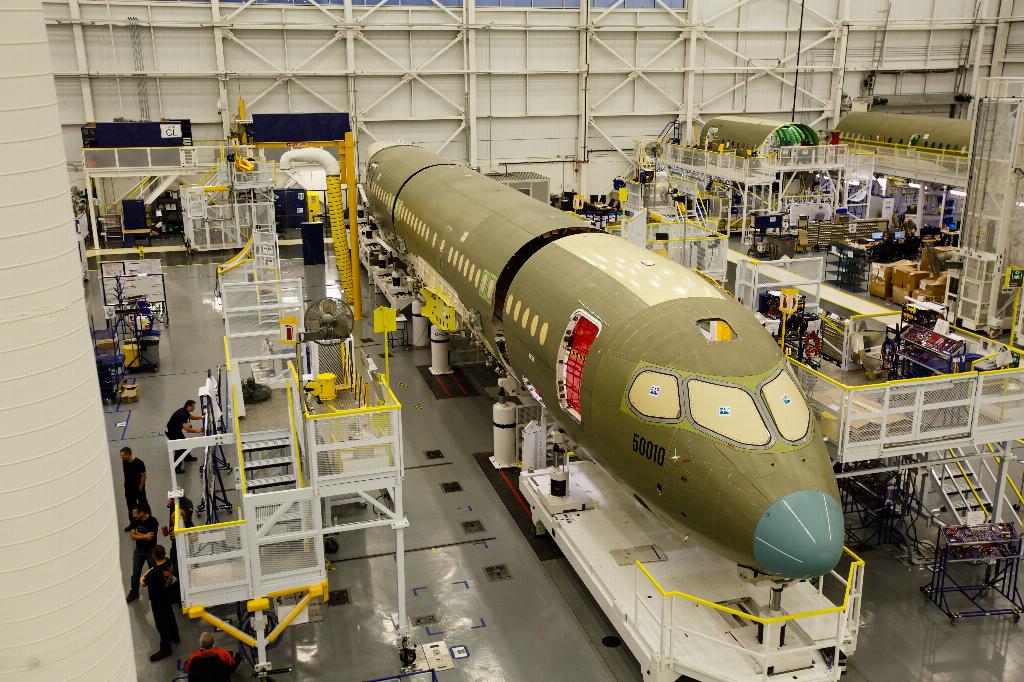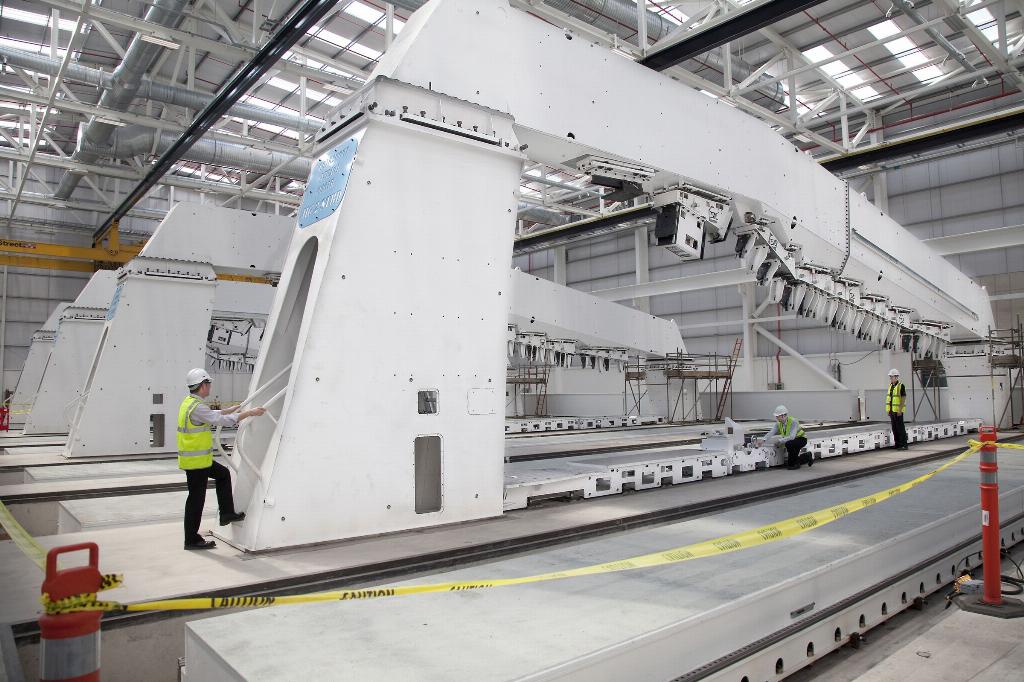Bombardier’s winged wonders

James Careless discovers how innovation helps streamline Bombardier’s C Series’ manufacture and assembly operations, enabling the airframe OEM to reduce cost without compromising quality.
Bombardier’s CS100 and CS300 narrowbody passenger jets are being pitched to airline customers as being 15% cheaper to operate and 20% more fuel-efficient compared to rivals such as Airbus’ A319/A320 and Boeing’s 737.
But that’s not all. Bombardier is also promoting the CS100 and CS300 as costing less for airlines to acquire than competitors’ comparable airframes. For Bombardier to deliver these promised performance improvements - and do so at an affordable price while making money for the Canadian aerospace manufacturer, means that costs have to be reduced during the manufacturing and assembly process without compromising quality. Here is how Bombardier is making that happen.
Bombardier’s cost-saving approach to the C Series includes having both its own and third-party suppliers provide the company with completely-built aircraft sections, which undergo final assembly in the company’s plant in Mirabel, Quebec. Bombardier Aerospace Belfast is where the composite wings are made using a unique manufacturing process that’s faster than conventional composite production approaches.
Specifically, Bombardier Belfast lays out and then autoclaves the C Series’ main composite wing skins using its resin transfer infusion (RTI) process. Rather than employ the standard approach of applying successive sheets of resin-impregnated composite fabric on top of each other to build the wing skins up, Bombardier Belfast starts by assembling resin-free already-layered/pre-cut composite sheets and stringers in the wing skin mould, and then injects the resin into the assembled wing skin before heating it in the autoclave. The difference is akin to making a cake from scratch compared to using a cake mix where only milk and eggs are required to finish the mixing. The C Series wing is laid out in one layer, injected, baked to perfection and then attached to a one-piece spar for attaching the wing to the main fuselage afterwards.
Clearly, this approach saves time by simplifying wing assembly; especially because components such as stringers that would be added mechanically in metal-winged aircraft are incorporated into the wing skin autoclaving process.
“In this case, you have an upper and lower skin with all the stringers (already) attached; they’re all one part,” said Bombardier Belfast composite operator Stephen Wheeler; speaking in the Bombardier corporate video ‘C Series – Transonic Wing’. “Immediately, at one stroke, you’re doing away with a large number of parts and a large number of traditional fixings, (such as) rivets, nuts and bolts.”

Interior innovations
Montreal’s Zodiac Aerospace is responsible for supplying the entire C Series cabin, including the seating, overhead bins, and washrooms. The Mirabel assembly plant then incorporates Zodiac’s interiors directly into its CS100s and CS300s.
Zodiac is saving Bombardier substantial assembly time by building the C Series’ overhead bin sections with interior lighting, air distribution, and electrical wiring integrated into their structures. This makes assembling these subsystems much quicker than if Bombardier had to do them all separately, while having the necessary parts already in place eliminates the need to stock, track, and distribute these parts to the Mirabel shopfloor.
Although Zodiac’s approach is a time-saver, it is also using its C Series contract as an opportunity to introduce innovations into this narrowbody aircraft. They include overhead bins that have more room than standard storage areas, and that rotate downwards when opened to allow for easier loading and unloading.
Meanwhile, the C Series’ rear washroom has been made wheelchair accessible, while the aircraft’s economy class seats have been made wider than the usual 17.5" (18.5" for aisle and window; 19" for the middle seat). At the same time, the C Series’ thinner carbon fibre composite seats only weigh in at 9kg compared to the usual 11-12kg found in other aircraft.
Laser-guided assembly
When it comes to assembling the C Series at its Mirabel plant, Bombardier is focused on doing the work accurately, simply, and expeditiously. This is particularly true when it comes to connecting together the various major elements, such as the wings, cockpit, centre fuselage, and aft fuselage.
“In our CRJ assembly plant or any other Bombardier aircraft assembly plant, our approach is to manually line up the sections to be mated, and work them back and forth until the best fit is achieved,” says Jean Piette, general manager of C Series Operations. “But the C Series assembly process uses an entirely different approach; one that relies on laser shoot analysis, virtual joining simulation, GPS-guided jigs and robotic drilling.”
Prior to arriving at the Mirabel facility, major components such as the wings and the fuselage portions are laser measured within thousands of inches at each supplier’s facility. Then, this data coming from all around the world – the forward fuselage from St. Laurent; wings from Belfast, rear and mid-fuselage from Shenyang, China; vertical and horizontal stabilisers coming from Foggia, Italy – is compiled. This data is then analysed to create a virtual simulation of aircraft assembly that supports predicting potential manufacturing adjustments weeks in advance.
“Suppliers, partners and the C Series Mirabel team can then prepare parts, robots and work scheme required for final adjustments while components are in transit to our final assembly line,” states Piette.

Once components arrive in Mirabel, the various elements of the to-be-assembled C Series aircraft are mounted on large scale jigs with GPS location measuring devices. At this point, the operations team use the virtual simulation results to align major components to their best fit atop programmed auto-guided vehicles (AGV) that are integrated into the manufacturing build sequence. Before any component is assembled, the production line technical team has already developed and programmed the best connection and alignment scenarios by using this simulation.
“Using the simulation, we can explore the best-fit scenarios before any holes are drilled,” explains Piette. “Only when we’re satisfied that the best alignment has been found do the robots move the major components to their final locations, and the actual assembly takes place.”
Lean methodologies
In a bid to lessen lead-times, Bombardier Aerospace Mirabel employs the Toyota Kaizen continuous improvement model, with its staff constantly analysing their processes to remove steps that do not add value or efficiency.
“This Kaizen analysis also took place with our flight test vehicles (FTVs),” notes Piette. “We did not just use our FTVs to validate the aircraft’s performance, but also used technical data experience from the build to improve the manufacturability, build sequence and testing; in terms of making it simpler without compromising quality.”
At the end of the day, Bombardier Aerospace’s innovative manufacturing and assembly approaches are all aimed at reducing the time and expense it takes to make these cutting-edge airliners, without negatively affecting their performance or structural integrity.
“We’ve already made substantial progress in cutting our production times, and we will make further progress as we build more C Series jets and get to know them better,” concludes Piette. “What we learn will further help us drive down our costs to customers, making our aircraft even more attractive to the world’s airlines.”













